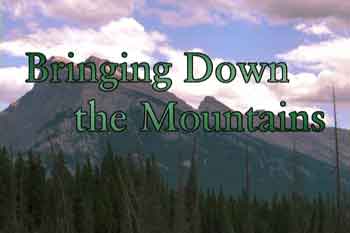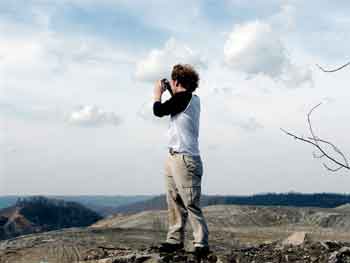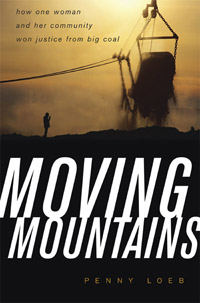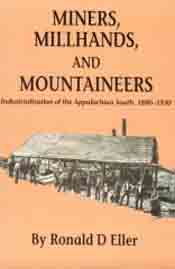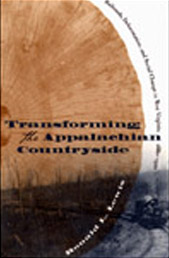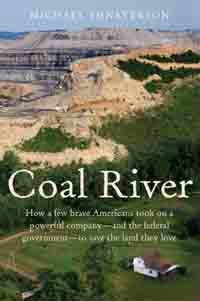- Mountaintop
Removal - Longwall Mining
- Acid Mine
Drainage
- Bonding
- Surface
Mine Act - Buffer Zone Rule
Mining Matters:
Focus on Mountaintop Removal Mining
Formed in 1967, the West Virginia Highlands Conservancy (WVHC) is the state's oldest environmental advocacy organization. Borne out of the need for battle to preserve scenic Seneca Rocks, WVHC continues today in response to a variety of ongoing challenges that threaten not only similar more widely known “special places” (e.g. Monongahela National Forest, George Washington National Forest, Canaan Valley Wildlife Refuge, and Wilderness areas like Otter Creek, Laurel Fork, Dolly Sods and Cranberry ), but also those that threaten the “special-ness of place”- the health and well-being of the air, water, forests and human communities of West Virginia.
For nearly four decades the Conservancy has been a leader in citizen efforts on a variety of mining issues critical to protecting the environment and life in WV. The organization’s monthly publication, the HIGHLANDS VOICE, documents many of these efforts – from administrative and legal attempts to defend the original intent of the Surface Mine Act and Clean Water Act, to preventing acid mine drainage and insisting on adequate financial guarantees to cover the cost of reclamation at mined sites. A key aspect of our work on mountaintop removal is our longtime effort to prohibit the dumping of mine waste into headwater streams, a critical factor in minimizing the size and impact of large-scale mining. A brief overview of our involvement follows.
1980’s
In 1986 WVHC successfully organized local opposition to the expansion of a 2,000 acre acid producing strip mine in Upshur county in central WV. The expansion would have included a 1-mile long valley fill in the headwatsers of a native brook trout stream and a 90 foot high dam across a farm field in the watershed below. A settlement agreement in a separate 1988 litigation against the state of WV resulted in significant, though short-lived, improvements in reclamation and the stability of fills at huge strip mines.
1990’s
In the early 1990’s requirements of the Clean Air Act as well as costly water treatment liabilities in the northern, higher sulfur, acid prone coalfields of WV, caused mining to shift to the southern coalfields. At the same time, tax credits enabled industry to invest in new technology and bigger machinery. Other financial incentives encouraged mining the thinner seams of coal that are layered in the southern mountains and are more difficult to mine. Mountaintop removal expanded beyond all expectations. During the ‘90’s WVHC played a key role in laying the groundwork for the growing opposition to mountaintop removal mining and in convincing regulatory agencies of the significance and overall impact of the ever-increasing number and size of fills being permitted. WVHC members participated in and reported on state sponsored mine tours, were appointed to legislative committees established to review state policies of mitigating for streams buried under valley fills, and wrote articles describing the practice and the convoluted permitting process. Members also participated in many public and media forums and debates with government and industry representatives. Appointed to the governor’s task force on mountaintop removal mining in 1998, WVHC offered a minority report that pointed to the illegality of filling streams and to the environmental and economic harm caused by mountaintop removal mining. In 1997 we compiled the first map visually documenting the extent of stream loss from mountaintop removal and valley fills in the three county area of Boone, Logan and Mingo in southern
A major plaintiff in the 1998 Bragg v Robertson litigation, WVHC was instrumental in convincing EPA to conduct the first ever Environmental Impact Study (EIS) on the effects of mountaintop removal mining and valley fills with the intent of finding ways to reduce the impact of those activities. Although the politically tainted recommendations of the final 2005 EIS called instead for streamlining the permitting process, the scientific studies contained in the report are invaluable as official documentation of the deleterious impacts of mountaintop removal mining and valley fills. Few permits were issued while the EIS was being prepared.
2000’s
The Conservancy continues its vigorous opposition to this environmentally destructive method of mining by engaging with others in litigation, education, actions, publicity and research. WVHC joined OVEC, CRMW and the Appalachian Center in comments objecting to over 40 inadequate industry applications to the Army Corps of Engineers for 404 fill permits and is currently a co-plaintiff in legal action opposing the Corps’ illegal permitting of large-scale mines without the required scientific study and review. We are also working with groups to oppose weakening amendments to environmental law, and are supporting local and regional community efforts to inform the nation and world of the travesty of justice called mountaintop removal.
Hobet
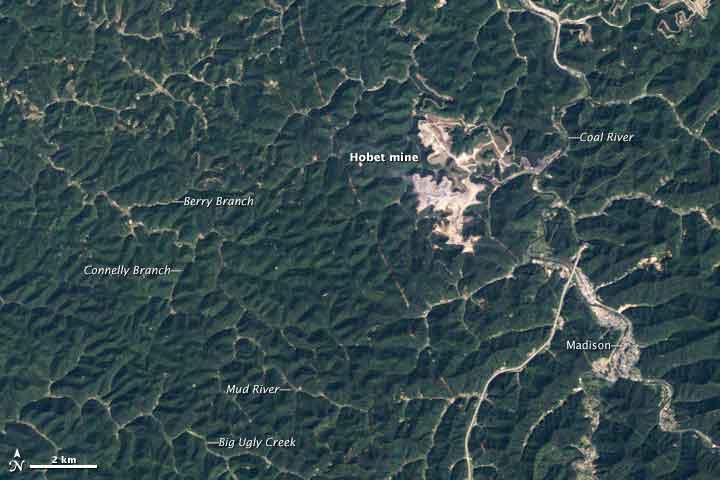 September 17, 1984
September 17, 1984
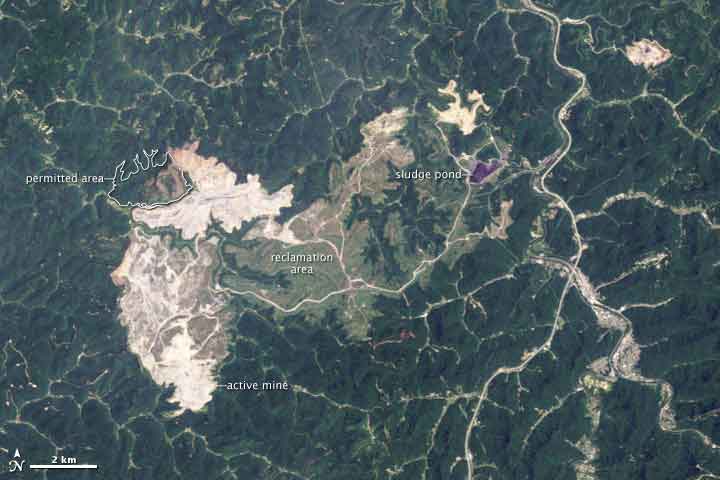 June 2, 2009
June 2, 2009
Below the densely forested slopes of southern West Virginia’s Appalachian Mountains is a layer cake of thin coal seams. To uncover this coal profitably, mining companies engineer large—sometimes very large—surface mines. This pair of images shows the growth of one of the largest surface mines in West Virginia during the past 25 years. The images are from the NASA Earth Observatory’s latest World of Change feature, Mountaintop Mining, West Virginia
Kayford Mountain
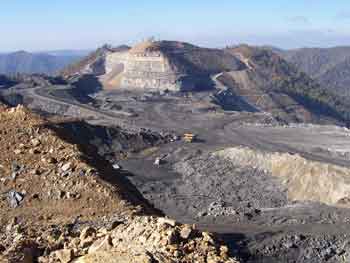
Photo by Julian Martin
Visit Kayford Mountain south of Charleston to see mountain top removal (MTR) up close and hear Larry Gibson's story about how he saved his mountain, now almost totally surrounded by MTR. Bring lunch for a picnic on Larry's mountain. Call in advance to schedule. Julian Martin (304) 342-8989; martinjul@aol.com or Larry Gibson (304) 542-1134; (304) 549-3287.
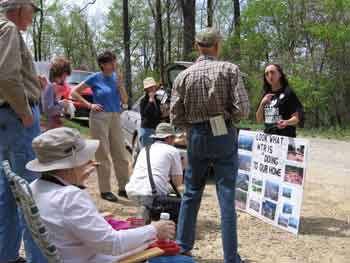
Photo by Cindy Rank
West Virginia Highlands Conservancy members on a visit to Kayford Mt. during the Spring Review, April 2006.
.jpg)
Photo by Cindy Rank
Marie Gunnoe from Van WV talks to WVHC members about mountaintop removal
View the video "Bringing Down the Mountains" made by three high school students from Greensburg PA.
Videos from iLoveMountains.org
On March 12, 2006 a group of students from Xavier University had a field trip to Kayford Mt. Click here to see the pictures they took.
The page background photo and the photos in the header banner are from the photos they took
Maps of Surface Mining in the Southern Counties of WV
| MOVING MOUNTAINSby Penny Loeb | |
| How One Woman and Her Community Won Justice from Big Coal | |
The Clash over Coal in the Mountain State
Author Penny Loeb first became interested in the mountaintop removal conflict in 1997, when she authored an award-winning article on the matter for U.S. News and World Report. In Moving Mountains: How One Woman and Her Community Won Justice from Big Coal, she recounts the story of Patricia Bragg, a Pie, West Virginia, native whose community was upended when coal companies chiseled into the nearby mountains in 1994. After longwall machines used in deep mining sapped her neighbors’ wells, Bragg rallied her community to demand rights for the neighborhoods devastated by the mining. With Bragg at the helm, eighty-eight homeowners sued the U.S. Army Corps of Engineers for their failure to comply with the Surface Mining Control and Reclamation Act. Lead by lawyer Joe Lovett, their dispute culminated in Bragg v. Robertson, a historic case that temporarily halted mountaintop dumping in the nearby valleys and forced the implementation of proper resurfacing techniques. Though Loeb heralds the victory of the Pie community, Moving Mountains is not strictly an antimountaintop removal treatise. Loeb approaches the controversial issue from all angles, including perspectives from the miners, citizens, politicians, and coal companies involved. She offers detailed profiles of how Bragg v. Robertson affected individuals such as Lovett, miner Bob Schultz, African- American legislator Arley Johnson, and housewife Vicky Moore. Loeb notes that the efforts of Bragg are part of a wider movement taking place over the past fifty years as activism in Appalachia has broadened from isolated debates over individual issues into widespread community action and empowerment. Education and legislation on mountaintop removal and other harmful mining practices are beginning to bring miners and citizens together in order to determine the best solutions for all involved. Moving Mountains documents a bold step taken towards seeking a common solution that will benefit both the environment and regional economies sustained through coal mining. Penny Loeb, a freelance writer who lives outside of Washington D.C., is a former senior editor at U.S. News and World Report and a former investigative reporter for Newsday. She has received numerous awards for journalism and was a finalist for the Pulitzer Prize in 1988 July 27, 2008 CHARLESTON, W.Va. -- ForeWord Magazine, which promotes books released by university and independent publishers, gave a Bronze Award in its 2007 environmental category to Penny Loeb's "Moving Mountains" about mountaintop removal coal mining in West Virginia Bragg soon became involved in a broad lawsuit against the U.S. Army Corps of Engineers, called Bragg v. Robertson, which temporarily halted mountaintop removal after a ruling by the late U.S. District Judge Charles Haden II. Loeb, who lives with her husband in Loudoun County, Va., was previously a senior editor at "U.S. News & World Report" and investigative reporter for "Newsday." The University Press of Kentucky in Louisville published "Moving Mountains." |
|
| Big Coal-The Dirty Secret Behind America's Energy Future | |
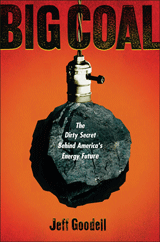 |
by: Jeff Goodell ISBN-13/EAN: 9780618319404; $25.95 |
| LOST MOUNTAIN | |
| A Year in the Vanishing Wilderness by Erik Reece | |
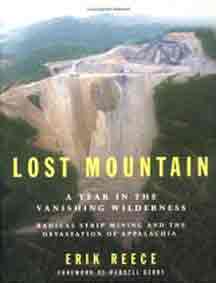 |
Interview with Erik Reece |
| Bringing Down the Mountains by Shirley Stewart Burns | |
The Impact of Mountaintop Removal on Southern West Virginia Communities |
|
“Bringing Down the Mountains not only tells the story
Author / Editor: Shirley Stewart Burns |
|
| Miners, Millhands, and Mountaineers by Ronald D. Eller | |
| Industrialization of the Appalachian South, 1880–1930 | |
As a benchmark book should, this one will stimulate
|
|
| Transforming the Appalachian Countryside by Ronald L. Lewis | |
| Railroads, Deforestation, and Social Change in West Virginia, 1880-1920 | |
An important contribution to the growing body
|
|
Coal River by Michael Shnayerson |
|
| How a few brave Americans took on a powerful company---and the federal government ---to save the land they love | |
One of America’s most dramatic environmental battles
Michael Shnayerson first traveled to the coal fields four years ago, on assignment for Vanity Fair. There he met an inspiring young lawyer named Joe Lovett, who was fighting mountaintop removal in court with a series of brilliant and daring lawsuits. He also met Judy Bonds, whose grassroots group, the Coal River Mountain Watch, was speaking out in a region where talking truth to power was both brave and dangerous. The two had joined forces to take on Massey Energy, the largest and most aggressive of the coal companies, and its swaggering, notorious chairman, Don Blankenship. |
|
| Strange as This Weather Has Beenby Ann Pancake | |
Set in present day West Virginia, Ann Pancake’s
|
|
Mining Matters:
Longwall Mining
Coming Soon
Page Under Construction



Mining Matters:
Acid Mine Drainage
Coming Soon
Page Under Construction



Mining Matters:
Bonding
Coming Soon
Page Under Construction



Mining Matters:
Surface Mine Act
Coming Soon
Page Under Construction



Mining Matters:
Buffer Zone Rule
Coming Soon
Page Under Construction




